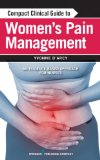Compact Clinical Guide to Women's Pain Management An Evidence-Based Approach for Nurses

Author: Yvonne D’Arcy, MS, CRNP, CNS
Affiliation: Suburban Hospital - Johns Hopkins Medicine, Bethesda, MD
Publisher: Springer Publishing Company
Publication Date: 2014
ISBN 10: 0826193854
ISBN 13: 9780826193858
eISBN: 9780826193865
Edition: 1st
Affiliation: Suburban Hospital - Johns Hopkins Medicine, Bethesda, MD
Publisher: Springer Publishing Company
Publication Date: 2014
ISBN 10: 0826193854
ISBN 13: 9780826193858
eISBN: 9780826193865
Edition: 1st
Description:
Recent research studies have indicated that there is a difference between the pain experienced by men and that experienced by women. This is the only clinical reference specifically geared to management of all commonly presented pain conditions particular to women. It is written by an NP Pain Management Specialist for nurses in all settings, and provides evidence-based guidelines for treating women's pain as a unique entity. Concise and portable, the guide delivers key information and helpful pain strategies that will support individualized pain management approaches and help to improve pain management outcomes. The guide provides quick access to nursing guidelines for treatment of pain due to fibromyalgia, TMJ pain, phantom breast pain, postmastectomy pain syndrome, menstrually related migraine headaches, irritable bowel syndrome, interstitial cystitis, and STD-related and pelvic pain. Pharmacologic and non-pharmacologic treatment options, current information from national guidelines (including using a combination of pain management scales for optimal pain assessment and management), along with regional anesthesia techniques, patient-controlled analgesia, and epidural pain management are also included. In addition, the guide discusses options for managing extreme pain situations, how to screen and treat potential substance abusers, and the physiologic bases of gender-different pain responses. Each chapter features a section called 'Nursing Considerations' which focuses on interventions and techniques to improve outcomes. Of particular note is a section on managing pain in obese women who suffer from pelvic pain syndromes and fibromyalgia, among other types of pain.
Related Titles
